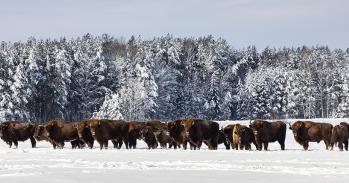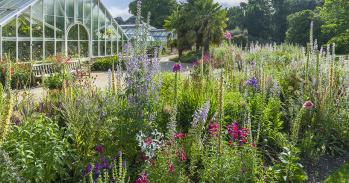
To protect the Amazon and support the wellbeing of its people, its economy needs to shift from environmentally harmful production to a model built around the diversity of indigenous and rural communities, and standing forests.
To protect the Amazon and support the wellbeing of its people, its economy needs to shift from environmentally harmful production to a model built around the diversity of indigenous and rural communities, and standing forests.
A group of conservationists from Bolivia, Brazil, Peru, Ecuador, the US and the UK say that current conservation and development efforts will never sustain or scale without systemic changes in how economies are designed.
Despite extensive destruction of the Amazon in the name of economic development, Amazonian communities have seen little improvement in income, life expectancy, and education. The researchers have proposed a new model and associated policy changes that could create fair and sustainable futures for the Amazon and its people by improving infrastructure, supply chains, and social organisations.
Their results, reported in the journal Nature Ecology and Evolution, are focused on the Amazon, however the researchers say similar economic models could be implemented around the world if the political will exists.
The Amazon basin is home to the world’s largest tropical rainforest, representing over half of the world’s remaining rainforest, and stores vast amounts of carbon. However, decades of large-scale deforestation, as well as the increased risk of fires and floods due to climate change, has put much of the Amazon rainforest under threat. In addition to what the loss of the Amazon would mean for global carbon emissions, the rainforest is also home to many indigenous peoples and thousands of species of plants and animals.
“We need a different vision for the Amazon if we’re going to protect it,” said lead author Professor Rachael Garrett from the University of Cambridge’s Department of Geography and the Conservation Research Institute. “Half a century of deforestation and exploitation of the Amazon has not resulted in widespread development, and now the economic value of deforested areas is threatened, not to mention the threats to the global climate and water security.”
Working with colleagues from the Amazonian region, Garrett has proposed building on the success of indigenous and traditional communities to develop new economies, which could protect much of the Amazon while also improving the livelihoods, health, and food security of the many people who live there. These economic models are known as socio-bioeconomies, or SBEs.
“Conventional economic models can result in short-term gains, but over the longer term, the people and resources of the Amazon basin have been exploited by powerful interests, while there has been an underinvestment in education, innovation, and sustainable infrastructure,” said Garrett. “The conventional economic model is simply not sustainable.”
The SBE model is focused on using and restoring Amazonian and other ecosystems sustainably, and supporting indigenous and rural communities. An SBE economy might include eco-friendly tourism, or the sustainable harvest and processing of plant products into valuable foods, beverages, clothing, and medicines.
“A limited range of interests are controlling the development agenda in most countries,” said Garrett. “The only way we can change that is improving the rights and representation of the people who are not benefiting from the systems and are being harmed by ongoing environmental destruction. We believe it is possible to have win-wins for humanity and conservation, but not if we continue to consume products that have a massively negative impact. SBEs can help put these win-wins into policy and practice.”
Garrett cites the footwear brand Veja as an example of such a win-win. The French company buys the rubber for its trainers from small-scale Amazonian rubber farmers, and purchases 100% of the responsibly harvested native rubber in Brazil. As part of its sustainability efforts, the company focuses on building communities of small-scale farmers and has been financially successful without traditional advertising.
Garrett and her collaborators are calling for massive increases in social mobilisation, technology and infrastructure to support SBEs. Under an SBE model, governmental subsidies would be redirected away from agribusiness and toward smaller-scale sustainable development. The researchers also outline how to build connections between rural and urban policies in SBEs. An example is the establishment of public procurement programmes where healthy and sustainably produced foods are purchased directly from indigenous and small farming communities and served in school lunch programmes and hospitals, instead of supporting large-scale agribusiness engaged in degrading practices.
Other policy changes that could support an SBE model include redirecting finance to conservation and restoration activities, supporting community enterprises, and ensuring participatory processes to ensure inclusive, long-term benefits.
“It’s possible to have an economy that is strong and works for everyone when we dare to develop new models and visions that recognise the interconnectedness of people and nature,” said Garrett. “By popularising these ideas, investing in people and businesses who are making a difference, and supporting research into SBE innovation we can support a transformation in both conservation and development in the Amazon.
“The SBE model could help protect the Amazon and its people while avoiding climate and biodiversity disasters, but there needs to be the political will to make it happen.”
Rachael Garrett is the incoming director of the University of Cambridge Conservation Research Institute and a Fellow of Homerton College, Cambridge. She is a council member of the Cambridge Conservation Initiative and serves on the UN Science Panel for the Amazon.
Reference:
Rachael Garrett et al. ‘Transformative changes are needed to support socio-bioeconomies for people and ecosystems in the Amazon.’ Nature Ecology and Evolution (2024). DOI: 10.1038/s41559-024-02467-9

The text in this work is licensed under a Creative Commons Attribution-NonCommercial-ShareAlike 4.0 International License. Images, including our videos, are Copyright ©University of Cambridge and licensors/contributors as identified. All rights reserved. We make our image and video content available in a number of ways – on our main website under its Terms and conditions, and on a range of channels including social media that permit your use and sharing of our content under their respective Terms.




